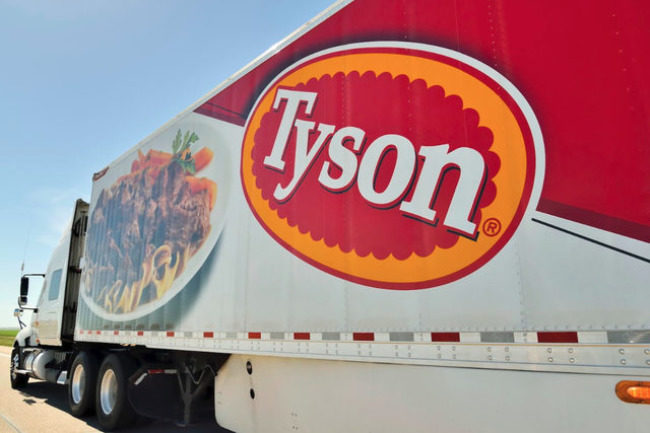SPRINGDALE, ARK. – Highlighted by a record year in its beef segment and looking to the future with a plan to deliver more than $1 billion in productivity gains over the next three years, Tyson Foods Inc. announced positive results for its fiscal fourth quarter and 12 months ended Oct. 2, 2021. The company’s adjusted operating income of $1.15 billion ($2.30 per share of common stock) in the fourth quarter was 26% higher than the $911 million ($1.70 per share) reported during the same period last year. For the 2021 fiscal year, Tyson’s operating income was $4.29 billion ($8.28 per share), an increase of 42% over last year’s $3.01 billion. Sales for the quarter were $12.81 billion compared to $10.64 billion. Sales for fiscal year were $47.05 billion, compared to $42.37 billion during fiscal 2020. The company expects sales of between $49 billion and $51 billion during fiscal 2022.
In a call with analysts, Tyson officials repeatedly mentioned the market headwinds of the past year, including a labor shortage, higher costs for feed, transportation and freight costs and ongoing challenges related to COVID-19, which resulted in volume decreases and challenges in several business segments.
“We saw our volume recover in the second half after the pandemic lows to finish the fiscal year just slightly down,” said Donnie King, president and chief executive officer. “We delivered double-digit sales and earnings growth in a challenging year.”
King said protecting its employees continues to be a priority and the company invested $65 million in COVID-19-related expenses in the quarter and $335 million during the year.
According to Tyson, “These direct incremental expenses primarily included team member costs associated with worker health and availability including direct costs for personal protection equipment, production facility sanitization, COVID-19 testing and vaccinations, donations, product downgrades, rendered product and certain professional fees, partially offset by CARES Act credits.”
Tyson officials also announced plans to improve productivity moving into fiscal 2022 and beyond.
“To foster continuous improvement and faster decision making, we’re launching a new productivity program designed to deliver more than $1 billion in annual savings by the end of 2024,” King said. “The focus of this plan includes operational and functional excellence, digital solutions, and automation and advanced technologies.”
The company said it expects to realize savings of approximately $400 million by utilizing automation and robotics, $300 million in operational and functional excellence, including increasing efficiency at plants; and $250 million in digital solutions, which includes utilizing artificial intelligence as part of improving efficiencies in its logistics and supply chain management.
Tyson’s Beef segment reported a significant increase in its operating margin, at 22.9% for the quarter on operating income of $1.15 billion and sales of $5.01 billion compared to 2020’s $466 million and 10.9% margin. Sales volume decreased more than 15%, for the quarter, which the company attributed to the industrywide labor shortage. Strong global demand for beef was one reason for the company’s 0.3% sales volume increase during fiscal 2021. For the year, the Beef segment operating income topped $3.24 billion and an operating margin of 18% compared to the previous year’s $1.58 billion and a 10% margin. Beef volume for the fiscal year was 7.3 billion lbs, up from 7.1 billion lbs in 2020 and down from 7.6 billion lbs reported in fiscal 2019.
Tyson’s Chicken segment reported an operating income loss of $113 million for the quarter compared to the same period in 2020, which was positive $91 million. Chicken segment sales, however increased for the quarter, at $3.87 billion versus $3.19 billion in 2020, and for the fiscal year, with sales of $13.73 billion in 2021 compared to $12.99 billion the prior year. For the year, the company’s Chicken business reported an operating margin of $24 million, down from $148 million during 2020.
“Despite a strong demand environment, volume decreased due to the impacts associated with a decline in hatch rate, a challenging labor environment and disruptions due to severe weather in the second quarter of fiscal 2021,” Tyson said in its earnings report.
The company’s Pork segment reported higher sales for the quarter at $1.65 billion, compared to 2020’s $1.27 billion. For the year, pork sales were $6.28 billion compared to $5.03 billion in 2020. Pork adjusted operating income was $78 million for the quarter, with a margin of 4.7% compared to $162 million and a 12.8% margin during the same quarter of 2020. For the year, Pork segment operating income was $328 million (5.2% operating margin) compared to $555 million in fiscal 2020 (11% margin). Rising input costs including live hog pricing, transportation and labor were headwinds in the segment but demand for pork was strong.
“Operating income decreased primarily due to lower hog supplies relative to industry capacity as well as production inefficiencies related to COVID-19 and a challenging labor environment, partially offset by a reduction in direct incremental expenses related to COVID-19 in fiscal 2021 as compared to fiscal 2020,” Tyson said.
Prepared Foods segment sales of $2.25 billion for the quarter topped the previous year’s $2.11 billion while volume decreased 12.5%, due in large part to the labor shortage and supply challenges. For the year, sales in the segment were $8.85 billion, compared to $8.37 billion in 2020. Volume for the year dropped 5.4% for the year due to the same reasons in addition to reduced foodservice demand in the first half of the year due to COVID-19 restrictions.



